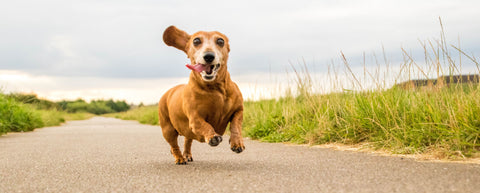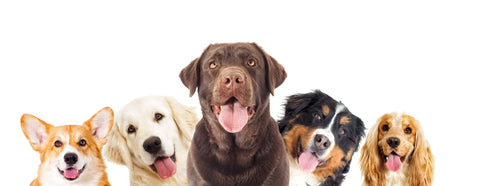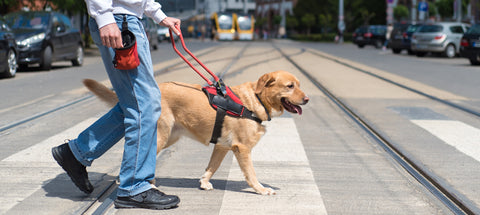If you’re wondering what’s the best exercise for old dogs, you’re not alone. Many pet owners with senior pups want to know how to keep their four-legged friend active as they get older. So, we’ve pulled together a list of all your most common questions, from the best indoor exercises for dogs, to the right joint supplements to choose for older dogs in particular. YuMOVE has the answers right here…

What’s the best exercise for old dogs?
First up, where should you begin when it comes to choosing the best type of exercise for a dog that’s gotten older? The answer here is pretty simple: you just need to make a few modifications to your normal exercise patterns, and always go at your dog’s pace.
Many of the exercises your dog enjoyed when he or she was younger will still be possible now, with a few tweaks. So, if you once loved walking around the local park, keep these walks up but reduce the distance to one that your dog is comfortable with.
Take each walk at a slower pace, and make regular stops along the way, keeping a close eye on your pooch for signs of tiredness. You could also consider driving to the park – or wherever it is you’re heading – instead of walking there, if they can’t quite manage both.
The benefits of exercise for dogs
The benefits of continued exercise of older dogs are huge, so it’s well worth making these modifications. Just like us humans, our pets need to keep active to stay healthy and happy, and that doesn’t change when they get older. Making time for regular exercise has a long list of benefits including:
Weight management
Our four-legged friends need to burn off the calories to stay at a healthy weight. And as they age, their metabolism slows, making it even more important to stay active. Excess weight puts pressure on your dog’s joints and heart, so maintaining a healthy weight via exercise and good nutrition is the route to a happy and contented dog.
Healthy joints
As our much-loved pets age, they can suffer with occasional joint stiffness that can slow them down. Regular gentle exercise keeps their joints moving and helps them to stay mobile. And a specially formulated joint supplement for older dogs like YuMOVE Joint Care PLUS can help to soothe stiff joints and offer support.
Mental happiness
Nothing sets their tail wagging more than the promise of walkies, right?! And that’s because exercise undoubtedly increases your dog’s levels of happiness, partly because it’s a bonding opportunity. In fact, reports have noted increases in the neurochemicals associated with positive feelings and bonding – that’s beta-endorphin, oxytocin and dopamine – observed in dogs after activities like petting, playing and talking. The same chemicals increase in us pet parents, too, so everybody benefits!

What counts as exercise for a dog?
The great news is you don’t have to walk mile after mile to exercise a senior dog. Oftentimes, it’s the ‘little and often’ approach that will benefit your dog in the long-term.
Regular, short walks, modified low-impact games if they can manage it, and anything that gets them up and moving counts as exercise.
As well as physical exercises, mental exercises for dogs are important to keep your canine friend stimulated. Try some of these to exercise their brain:
Brain games: One of the easiest ways to incorporate brain games into your dog’s daily routine is with their food. Scatter feeding, for example, literally means dotting your pet’s food or a few of their favorite treats around the kitchen or garden instead of placing it in their bowl. It means they have to go looking for it, which works their natural foraging abilities and gets them up and moving in the process. It’s a little messy, but it’s worth it!
Trick training: Turns out you can teach an old dog new tricks! And doing so is great for mental stimulation. If you’ve already mastered sit, stay, come here and lay down, you could try teaching your dog the names of household items, for example, or any number of clever tricks for dogs. Doing this helps you bond and will also increase your dog’s confidence, which can take a hit as your pup ages.
Puzzle toys: There are some great interactive puzzle toys available, and they’re designed to get your dog using their natural problem-solving abilities. Again, this helps to boost their confidence and gives their brain a much-needed workout, so try to get them playing with it every day.
How much exercise is needed for my dog?
The answer to this one will vary from one dog to the next, and your veterinarian can advise, but as an absolute minimum you should spend 30 minutes every day doing some form of activity with your dog – ideally more. Older dogs may not have the stamina to exercise for very long, so short bursts of exercise throughout the day are a better idea than one long activity.
Remember, brain games and indoor exercises count too, and you can let your dog stretch their legs out in your yard if you have one.
Are walks enough exercise for a dog?
An older dog can get all the exercise they need from regular walks, so long as you’re using this walking time wisely and building in activities that will also stimulate their brain.
Let your pooch explore and sniff while they’re walking, for example, and let them meet other dogs when it’s safe to, to help with their socialization skills. This builds doggy confidence, which is really important for older dogs whose sight or hearing may be failing. When this is the case, the simple act of going for a walk can be a potentially scary experience – something that YuCALM Calming Soft Chews can also help support your dog with.
If your four-legged friend is not able to walk far at all, consider swimming. It’s a great option for older dogs as it’s not weight-bearing, so they can build muscle without putting stress on their bones and joints.
Is indoor exercise for dogs a good idea?
In a word, yes! Indoor exercise is ideal for older dogs, and particularly for pet parents without a back yard. Younger pups will enjoy playing and doing indoor obstacle courses, for example, whereas older dogs will love things like indoor hide and seek with doggy treats. This encourages them to get active and stimulates their mind – so it’s a workout for brain and body.
Playing brain games, teaching your pooch a new trick, and letting them play with puzzle toys will all encourage your pet to get moving inside the home. You could also consider buying a pet treadmill, which is ideal if you have mobility issues. Just make sure it’s specifically designed for dogs and that your pooch is never left to exercise on it alone.
What size exercise pen should I get for my dog?
If you’re considering an exercise pen for your four-legged friend, you’ll need to think carefully about the size depending on the size of your pooch. Dog playpens can be super useful as they both contain your dog and allow them enough space to move around and play. They can be handy for travel and can be used indoors or outside – just make sure there’s shade and water if it’s outdoors.
When you buy an exercise pen, the store should ask about the breed and weight of your dog as there’s no one-size-fits all rule here. The American Kennel Club has some good advice about the different types of pens on offer, and indoor pens are generally smaller than outdoor versions.
What about exercises for dogs with vestibular disease?
Canine Vestibular Disease can come on from seemingly nowhere in older dogs. One minute your precious pooch is fine, and the next they can barely stand up straight or have collapsed on the floor.
Vestibular disease affects your dog’s inner-ear sensory receptors, which is crucial to control’s their balance. Vestibular structures send information to the brain about where the body is in space, so when they don’t function correctly it can lead to some very alarming symptoms.
Thankfully, the symptoms of Canine Vestibular Disease usually begin to improve after around three days, but always take your pooch to get checked over by a professional.
In terms of exercise, your vet can advise, as your pet will need time to recover, and once this happens they can start finding their way around at home again and then can consider exercising again.
You might need to help them along and steer them out of danger while their balance improves, but it’s definitely worth encouraging some gentle walking like this once they’re able to.
Any tips for exercises for dogs with hip dysplasia?
Your pup’s joints bear the brunt of a great deal of pressure as they run, jump and play, and the hip joint can cause problems in particular. When the ball and socket of the hip joints haven’t developed normally, the joint wears prematurely and causes pain and mobility issues – better known as hip dysplasia.
If your four-legged friend is suffering from hip dysplasia you may notice things like:
- Stiff back legs
- Reduced thigh muscles
- Less active
- Unwilling to climb stairs
If you spot these symptoms, first have a veterinarian diagnose your dog’s condition. They can advise you on the best exercises for dogs with hip dysplasia, which usually involves short gentle walks avoiding things like jumping and running, which can aggravate the condition.
A final note on exercise for older dogs
As you can see, exercise is super important for ageing dogs – keeping your best friend active in their senior years will help them stay happy and contented, and simply means changing your approach to suit your pooch.
If you’re worried, always get advice from your veterinarian to find out what exercises and activities will suit your dog. And if you want to give them something to support their joints, consider adding a dog joint supplement to their diet.
As the saying goes, there’s life in the old dog yet!











